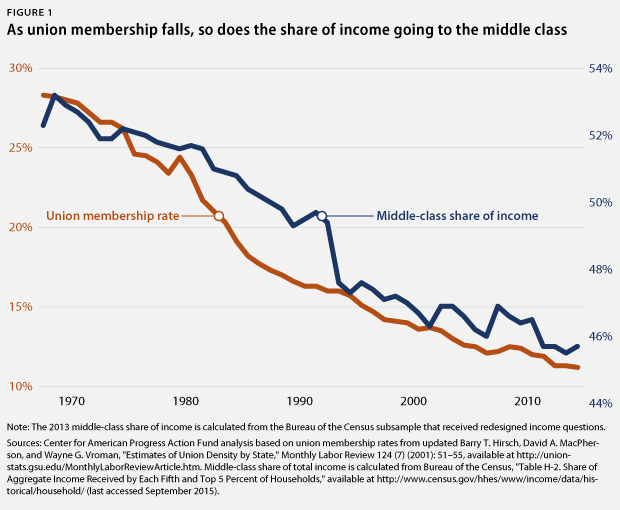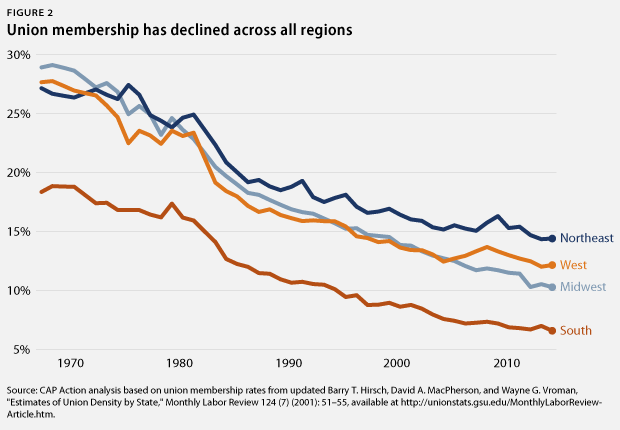The latest data from the U.S. Census Bureau confirm that the economic strength of the U.S. middle class continues to stagnate and is well below its historic potential. Although the change was statistically insignificant, real median household income fell from $54,462 in 2013 to $53,657 in 2014.* And with middle-class incomes stagnating while incomes at the top rise, the share of income going to the middle class remains near record lows.
This trend is exacerbated by the continued slide in labor union membership. A historically low share of American workers—just more than 11 percent—were union members in 2014. Without strong unions to advocate for higher wages and policies to benefit workers, reversing trends of unequal growth and rebuilding the middle class will prove to be difficult.
In 2014, the middle 60 percent of households brought home just 45.7 percent of total national income, a far cry from the 53.2 percent that they received at their peak in 1968. If that peak share had remained constant, then these middle-class incomes would be, on average, nearly $4,200 higher than they are today. U.S. national income is being increasingly concentrated among the richest households. The top 20 percent of households took home more than half of income in 2014—51.2 percent. The richest 5 percent of households received 21.9 percent of national income, up from 16.3 percent in 1968.
There are certainly many forces driving U.S. income inequality and the reduction in the middle-class share of income. Increasing globalization, new forms of technology, and other policy choices have a role to play. But it is critical to consider the importance of dwindling union membership rates. A variety of economic studies, including a recent study from economists at the International Monetary Fund, have found that rising income inequality is in part explained by deunionization.

The correlation between the declining middle-class income share and unionization rates is made clear in Figure 1. As the share of workers who are union members has dramatically fallen over recent decades, the share of income going to the middle class has contracted. While nearly 3 in 10 workers were unionized in 1967, the union membership rate has dropped by more than 60 percent over the past 47 years. And while today’s unionization rates vary between states, the decline has not been limited to certain states or even certain regions. As Figure 2 shows, each region of the country has seen its union membership rate drop over time.

Declining union membership is a cause of concern for the entire middle class, not just union members. The benefits of unions are not just limited to the increased wages and benefits accruing to those covered by collectively bargained contracts. In fact, new Center for American Progress research shows that areas with higher union membership are associated with greater economic mobility for all. This is not surprising when one considers that unions are among the few interest groups that advocate politically for middle-class interests. Additionally, unions help increase political participation, ensuring that our democracy works for everyone.
Policymakers should be focused on reversing the decline of the middle class and should remember the important role that unions play in achieving this goal. In fact, the American people realize that unions are a crucial part of rebuilding the middle class: Nearly 6 in 10 “approve of labor unions,” and a plurality of Americans “want unions to have more influence” than they have today. Our economy depends on a prosperous middle class, and that middle class needs the support of a strong labor movement.
* Note: The Census Bureau recently introduced new methods for surveying income. Our 2013 measures are from the Census Bureau subsample that received redesigned income questions. In 2013, the subsample that received the redesigned questions was shown to have a higher median household income than those who received the traditional questions. While this methodology is consistent with the 2014 data, this change could affect long-term data comparisons. See Appendix D of the Census Bureau’s “Income and Poverty in the United States: 2014” for more information.
Alex Rowell is a Research Assistant with the Economic Policy team at the Center for American Progress Action Fund. David Madland is the Managing Director of the Economic Policy team and the Director of the American Worker Project at the Action Fund.